|
Handheld Nautiz X7
Ultra-rugged Windows Mobile PDA with integrated GPS, altimeter, e-compass, camera, hi-res display for all sorts of GIS surveying and other GPS/mapping-based applications
(by Conrad H. Blickenstorfer; photography by Carol Cotton -- view PDF version)
The Handheld Group, located in Sweden and founded in 1997, is a worldwide suppliers of ruggedized handhelds for use in markets such as utility, military, logistics, forestry, transportation and field service. Handheld has a full lineup of rugged tablet computers and rugged industrial PDAs, such as the Nautiz X7 that is the subject of this review. The Nautiz X7 is an ultra-rugged GPS-enabled handheld computer literally brimming with advanced technology. It is designed to be a top-of-the-line handheld GIS surveying and mapping device that provides extra performance and ruggedness for the most demanding field applications. It's an attractive design with a handy keypad for rapid data entry, and represents an interesting addition to Handheld's lineup.
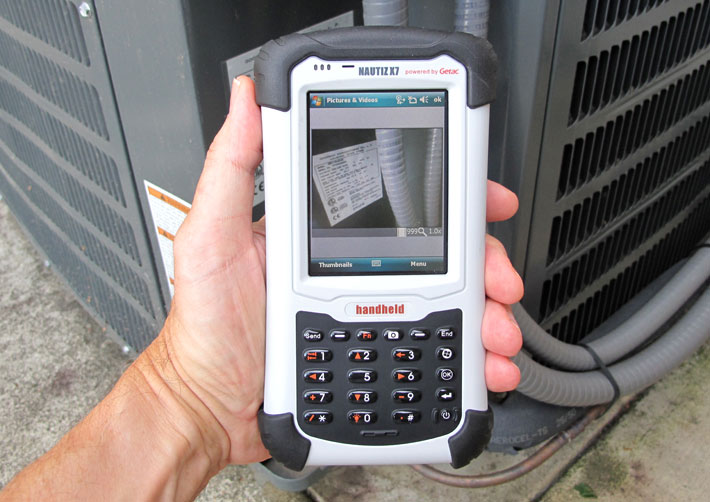
A ruggedized Pocket PC/scanner/phone/GPS system
As a premium supplier of a growing, cherry-picked lineup of some of the best handheld computers in the world, Handheld does not limit itself to one technology source. At this point the lineup is getting a bit crowded, what with the availability of the Nautiz X5 as well as the M3 Mobile and the Nomad, Recon and Ranger. They're all different, of course, but there's also some overlap and prospective customers need to educate themselves to avoid confusion, especially between machines that are quite close (like the X7 and the TDS Nomad).
As is, the Nautiz X7 platform is a fully rugged PDA based on the Windows Mobile platform. It was designed to bring general-purpose PDA functionality to field-based applications, with special emphasis on GPS/GIS applications, ruggedness and maximum performance. With a footprint of 3.5 x 7.0 inches and a thickness of an inch and a half, the device is too large for most pockets but small and handy enough to carry around. Weight is a bit over a pound, including battery. What sets the Nautiz X7 apart from most rugged Pocket PC-style devices is its integrated high-sensitivity GPS receiver and state-of-the-art technology.
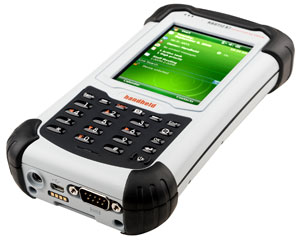 From a tech perspective, the designers and engineers who created this machine set the bar pretty high. On the display side, the 3.5" touchscreen display has full VGA 480 x 640 pixel resolution. That translates into 228 dots per inch, considerably sharper even than the Apple iPhone's 162dpi display. Combined with transflective sunlight-readable display technology, the very high resolution makes for excellent viewing quality of graphic-intensive files and detailed maps, even in bright daylight or snowy conditions. From a tech perspective, the designers and engineers who created this machine set the bar pretty high. On the display side, the 3.5" touchscreen display has full VGA 480 x 640 pixel resolution. That translates into 228 dots per inch, considerably sharper even than the Apple iPhone's 162dpi display. Combined with transflective sunlight-readable display technology, the very high resolution makes for excellent viewing quality of graphic-intensive files and detailed maps, even in bright daylight or snowy conditions.
Like the smaller Nautiz X5, the new X7 comes with a built-in 3-megapixel auto-focus camera, but unlike its siblling, it also has an integrated altimeter and an E-compass. These new features are meant to let field-based users capture a much richer, expanded range of field data on-site. Combined with the X7's integrated SiRFstar III GPS and available geotagging and GIS applications, this rugged handheld offers plenty of the advanced location-based systems functionality required in GIS applications, search-and-rescue operations, and similar deployments.
Thanks to its integrated GPS, altimeter and E-compass, the Nautiz X7 can provide accurate latitude, longitude, and altitude data as well as the ability to generate directional relations between the unit's position and that of a target. The built-in camera enables instant visual data capture on location and its resolution and quality are high enough so that taking a (fragile) camera along may not be necessary. Wireless connectivity options (including HSDPA WWAN) can be used to connect the X7 to a GIS server and instantly transmit or process data in the field. There are a lot of tools built into this unit that, combined with the proper software, make entirely new applications possible, applications that in the past either required multiple devices or simply were not available in the field.
Unlike much of the competition that still uses older XScale processors, the Nautiz X7 is based on Marvell's new PXA310 chip. The PXA310 is part of Marvell's PXA3xx family of application processors that offer higher performance as well as lower power consumption than the predecessor PXA255 and PXA270 chips used in millions of handhelds. Capable of running at clock speeds up to 806MHz, the PXA310 provides excellent speed, hardware video acceleration, DRM security and combines them with low-power modes ad the ability to dynamically adjust voltage and frequency for optimal battery life.
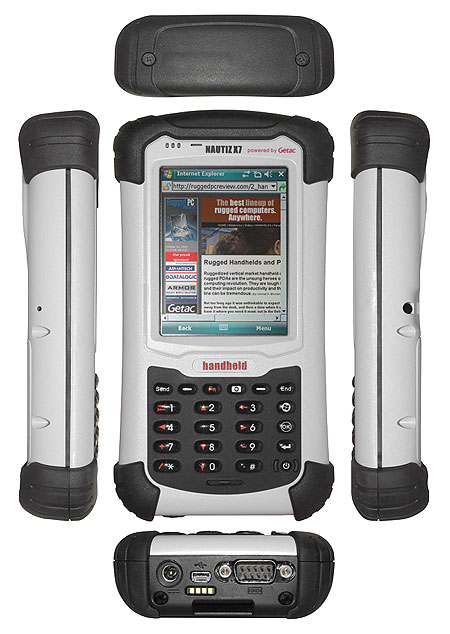 The Nautiz X7 also offers plenty of storage in the form of 4GB of onboard NAND Flash that can be complemented with an additional 8GB through an SDHC card slot. The Nautiz X7 also offers plenty of storage in the form of 4GB of onboard NAND Flash that can be complemented with an additional 8GB through an SDHC card slot.
The picture to the right shows the Nautiz X7 from the front and from all four sides. It looks and feels rugged and substantial, and like a tool for the job of a field engineer or anyone else whose job often includes roughing it on location and on the road. Oh, and if you wonder where the "Nautiz" name comes from, it's straight from the runic alphabet that goes back almost 2000 years (like some of Handheld's other names: Kenaz, Algiz, etc.). Runes usually have several meanings. Nautiz can mean "necessity" but also several other things and sentiments.
Anyway, going around the Nautiz X7:
- The top of the unit is protected by a thick rubber cap that also acts as a waterproof seal. Underneath the cap is the X7's SD card slot.
- The left side is unadorned. The little hole you see is really just a ventilation hole for the stylus garage.
- The right side likewise is all smooth and unadorned except for the stylus garage.
- On the bottom are the surface-mount docking contacts as well as a serial port and a USB port.
- The front side has, in addition to the screen and keypad, the microphone, speaker, and three indicator lights for phone, charge status and wireless radio status.
The design of the housing is smooth, clean and functional. Screws are deeply recessed, there aren't any small parts or details that could break off, and everything feels solid and built to last.
A peek inside
Since we usually cannot resist taking a peek inside the rugged systems we review, below is a look at the guts of the Handheld Nautiz X7. The interior layout, fit, and finish tells a lot about the thought that went into the design of a product, and also how well it is made. Note that our review unit was still in pre-production, so final units may look a bit different inside.
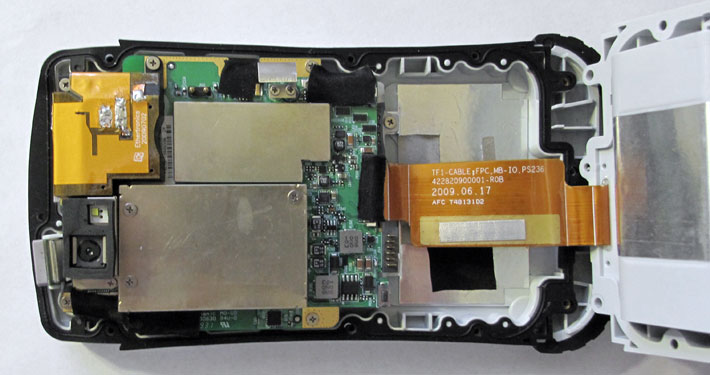
From a construction point of view, the Nautiz X7 consists of two very sturdy plastic halves. Sealing is via an intricate rubber gasket that goes around the entire perimeter of the device. So that thin black line going around the unit is not just for decorative purposes; it is the main seal that makes the unit waterproof. Openings in the shells (camera lens, ribbon cable slot, loudspeaker, etc.) are sealed via silicon glue. Two exceptions are the SD Card slot, the SIM slot, and the battery contacts that rely on good sealing and a tight fit of their respective covers. The LCD and the main circuit board are mounted on a magnesium chassis. The I/O circuit board at the bottom of the computer is really mounted outside, so don't be concerned when it looks like water might get in through one of the ports. It won't. However, if the unit is submerged, make sure the inside of the interface plate cavity is dried out. This approach, by the way, also lends itself to quick customization of interface requirements. A different interface board and bottom cap is conceivable, though we don't know if that's why it was designed this way.
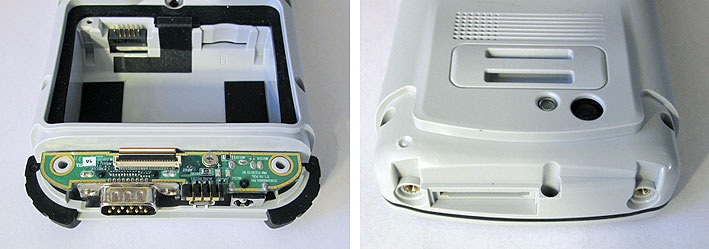
The battery compartment has its own rubber pressure seal. The battery compartment cover is metal (magnesium or aluminum) to make it rigid enough to form a reliable seal and presumably also to protect the battery. The battery compartment also provides access to the unit's SIM slot. The cover is secured and tightened with a locking bolt that can be operated by hand.
The top cap covers and seals the SD Card slot (shown on the right above). It is designed so that it can accommodate alternate end caps that may contain external peripherals using the SDIO interface.
Windows Mobile 6.1
Our review Nautiz X7 came with Microsoft Windows Mobile 6.1, which means it included a variety of Microsoft standard mobile applications and utilities. 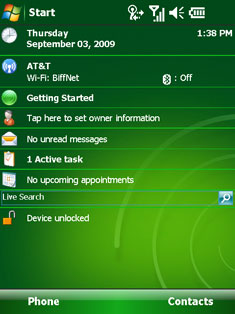 Among them are mobile versions of Word, Excel, PowerPoint and OneNote. It also includes PIM applications, mail, web browsing, Windows Messenger, a picture viewer and a good number of control panels. Among them are mobile versions of Word, Excel, PowerPoint and OneNote. It also includes PIM applications, mail, web browsing, Windows Messenger, a picture viewer and a good number of control panels.
Why did the designers pick Windows Mobile 6.1 instead of Windows CE 5.0 or 6.0 with their more industry-oriented look and feel and functionality? It's a judgment call. These days, Microsoft differentiates between Windows Embedded CE and Windows Mobile. Windows Embedded CE is a scalable 32-bit OS designed for intelligent devices ranging from enterprise tools such as industrial controllers, communications hubs, and point-of-sale terminals to consumer products such as cameras, phones, and home entertainment devices. Windows Mobile, on the other hand, is a platform that is also based on Windows Embedded CE, but has the more consumer-oriented look and feel and features required for PDAs and smartphones. A device like the Nautiz could be used either with Windows CE or Windows Mobile, depending on the intended application. In general, customers who design their own custom applications may lean towards a Windows CE implementation whereas customers with more general needs prefer the friendlier Windows Mobile platform. Microsoft recently released Windows Mobile 6.5 with a new user interface that seeks to copy the iPhone, but the underpinnings are largely unchanged.
Below are screen captures of some of the Nautiz's displays. To the left is the mobile Internet Explorer browser that works well enough (though nowhere near as well as the iPhone browser) and certainly has enough resolution to display even fairly complex pages. In the middle is the handy Windows Mobile Wireless Manager where you can turn radios on and off. To the left is an example of the many professional software apps you can run on the Nautiz X7.
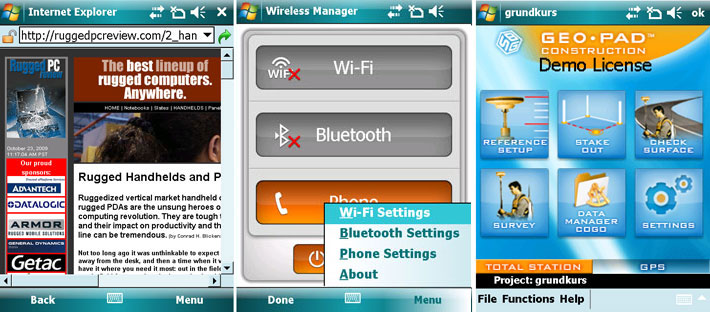
Below you can also see what the phone pad looks like (here without a SIM card installed), a screen with a number of scan demos and examples, and the e-Compass that can be used in stand-alone mode or integrated into custom applications.
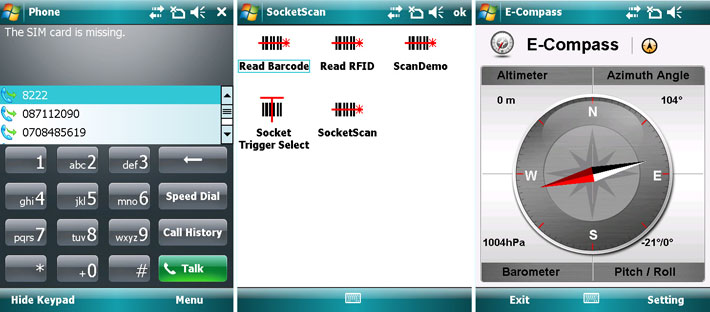
Controls and data input methods
As far as data entry and navigation go, you can interact with the Handheld Nautiz X7 either via touch screen or via keypad or both. The keypad also includes up/down, left/right, tab, plus, minus, slash and period as secondary function keys. One thing that's missing is the terrific Tegic T9 predictive text entry that millions of texting addicts use and love, and they are far more adept at T9 than any other text entry method. However, the X9's keypad really wasn't designed for text entry, and so this isn't a major omission, especially since the keys don't carry alpha labels.
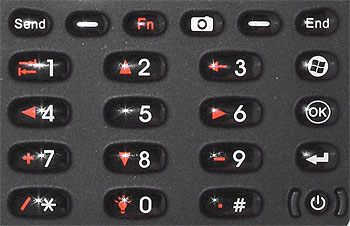 Above the display are three indicator lights. The one to the left glows blue when the phone is turned on. The one in the center flashes blue for Bluetooth, amber for WiFi and purple for GPS. The right one indicates charge status. Above the display are three indicator lights. The one to the left glows blue when the phone is turned on. The one in the center flashes blue for Bluetooth, amber for WiFi and purple for GPS. The right one indicates charge status.
For audio, there is a microphone below the keypad, a small earpiece speaker for phone operation above the display, and a larger main speaker in the back. There is no headphone connector, so you'll need a Bluetooth headphone for that.
For operation via stylus, the Nautiz X7 comes with a 4-1/2-inch telescope metal stylus with black plastic tip. When not in use, it fits into a slot on the right side of the device. You can also use touch to operate the Nautiz X7, but Microsoft clearly designed the Windows Mobile interface for use with a stylus.
For data entry, Windows Mobile offers a wealth of options. There is the integrated keypad. There is a nice pop-up keyboard and three are also no fewer than three different ways of recognizing text. They are:
- Block Recognizer, which uses the special Graffiti alphabet Palm invented in the 1990s. The idea here is that almost all letters are "unistrokes," or consisting of a single uninterrupted stroke, which makes them easy to recognize for the computer. The slightly abstracted alphabet is quite easy to learn. Millions used it on Palm Pilots.
- Letter Recognizer, which also recognizes individual letters instead of whole words, but uses the standard alphabet instead of the slightly modified one of the Block Recognizer. And whereas the Block Recognizer lets you shift case, the Letter Recognizer, which goes back to a product called "Jot" by (CIC) Communication Intelligence Corporation, has different data entry boxes for upper case, lower case and numerals.
- Transcriber, which is a full-function handwriting recognition system that also goes way back almost to the beginning of PDAs more than 15 years ago. Microsoft bought the rights to it a number of years ago and it's been part of Windows Mobile ever since.
Any of those input methods, once mastered, work very well. Below you can see screenshots of the onscreen keyboard, the Block Recognizer, and Transcriber.
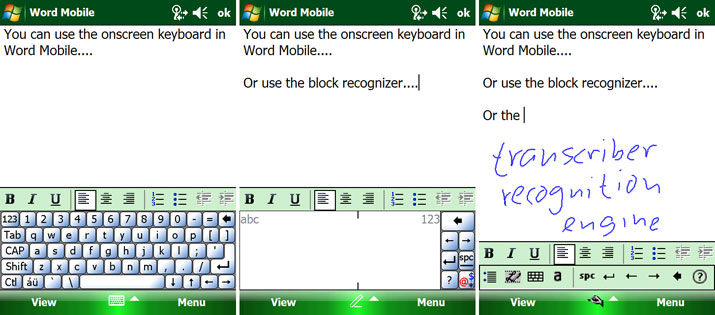
(Note: the above screen shots show generic Windows Mobile data input functionality)
Phone functionality
One of the things Windows Mobile is quite good at is its phone functionality, and the Nautiz X7 takes full advantage of that. Simply insert a SIM card and as long as you have an activated account for it, the X7 can be used as a rather powerful smartphone.
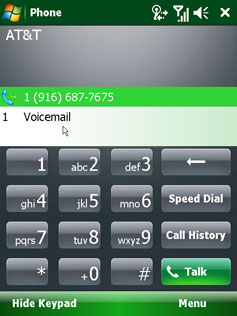 When using the Nautiz as a phone, you can tell that Microsoft has a good seven years of Pocket PC phone experience. Everything works and everything is logical and nicely integrated. For our testing I used the SIM card from one of our AT&T phones and it worked without as much as additional configuration. The X7's voice quality is very good, and, as is usually the case with vertical market handhelds that are also phones, actually better than that of most of today's chintzy dedicated phones. It's also quite obvious why Microsoft used to call this the "Pocket PC Phone Edition" -- they did not just add cell phone capability to a rugged PDA; the wireless capabilities are deeply integrated into the device and its software. When using the Nautiz as a phone, you can tell that Microsoft has a good seven years of Pocket PC phone experience. Everything works and everything is logical and nicely integrated. For our testing I used the SIM card from one of our AT&T phones and it worked without as much as additional configuration. The X7's voice quality is very good, and, as is usually the case with vertical market handhelds that are also phones, actually better than that of most of today's chintzy dedicated phones. It's also quite obvious why Microsoft used to call this the "Pocket PC Phone Edition" -- they did not just add cell phone capability to a rugged PDA; the wireless capabilities are deeply integrated into the device and its software.
To use the X7 as a phone, you either push the "send" button, push the soft "phone" button, or you select "Phone" from the Windows pulldown menu. The phone application shows the last calls, an onscreen keypad, and access to call logs and speed dial. The call log provides summary information about the number of calls and call time. Individual call log entries provide one-button call-back or SMS messaging as well as access to any notes that may be attached to a call. Or you can create a new Contacts entry automatically. You can also take notes during a call. The note will have the caller's name, the phone number, and the time of the call already on it. Needless to say, to take a note you'll have to use the Nautiz X7 with headphones and with the speakerphone on. Volume for the phone can be set separately from the system itself via a balloon slider box that is always accessible via the menu bar on top of the display.
What all this means is that the Nautiz X7 can be used as a full-function phone in addition to everything else it does. The "Send" and "End" buttons are tiny and they are white on black as opposed to the usual green for answer and red for hangup. No real problem. The screens below show some of the Windows Mobile phone functionality.
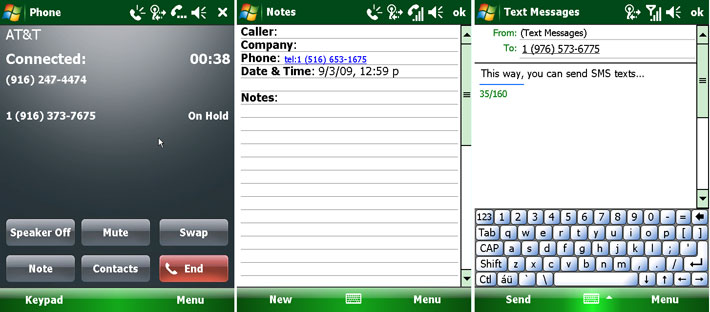
Communication and connectivity
Like most mobile devices today, the Nautiz X7 can connect in a variety of ways. Wired connectivity is both onboard and via dock. The X7 has a set of gold-plated surface-mount contacts to communicate with an optional office dock. The device itself has a full 9-pin RS232 serial connector as well as mini-USB host and client connector.
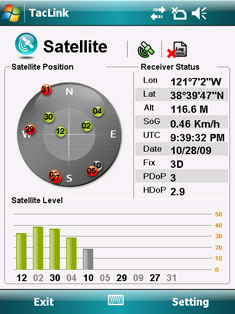 The Nautiz X7 comes standard with integrated 802.11b/g WiFi as well as Bluetooth V2.0 + EDR. A SIM slot, located inside the battery compartment, enables the unit to function as a phone and also enables HSDPA wireless WAN (Wide Area Network) communication. Select models are equipped with a HSDPA (High-Speed Downlink Packet Access) module. HSDPA is an enhanced 3G (third generation) mobile telephony communications protocol that can operate on the 850/900/1800/1900/2100MHz bands. The Nautiz X7 comes standard with integrated 802.11b/g WiFi as well as Bluetooth V2.0 + EDR. A SIM slot, located inside the battery compartment, enables the unit to function as a phone and also enables HSDPA wireless WAN (Wide Area Network) communication. Select models are equipped with a HSDPA (High-Speed Downlink Packet Access) module. HSDPA is an enhanced 3G (third generation) mobile telephony communications protocol that can operate on the 850/900/1800/1900/2100MHz bands.
When within range of a network, 802.11b/g wireless can be used for web browsing, email, terminal emulation sessions, synchronization or, thanks to the unit's microphone and speaker, for VoIP (Voice over IP) voice communication.
With infrared communication no longer as popular as it once was, the Nautiz X7 has foregone an IrDA port. IrDA still comes in handy for peripheral connectivity and even synchronizing, but it is no longer absolutely necessary.
Connection to a PC for synchronizing or communication with a backend server or peripheral can be via USB, WiFi, WWAN, or Bluetooth. Relationships can be established via standard Microsoft ActiveSync.
The Nautiz X7 also includes an integrated state-of-the-art SiRFstarIII GPS module that provides 5 meter (~17 feet) accuracy in autonomous mode, 1-3 meters (3-10 feet) with SBAS (WAAS/ENGOS/MSAS), and sub-meter (less than three feet) accuracy with post-processing. The included TacLink utility displays satellite position as well as a slew of location data.
3-megapixel camera
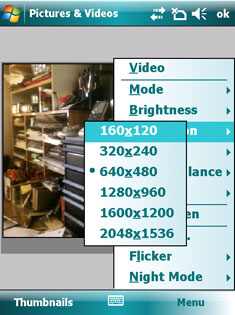 Like almost all modern handhelds and smartphones, the Nautiz X7 has an integrated camera. Thanks to advanced CMOS imager technology, it is now possible to have high resolution still and video camera functionality even in very small devices. In terms of speed and image quality, these camera modules are not meant to replace a standard photographic camera by any means; they are simply meant to provide additional functionality. Like almost all modern handhelds and smartphones, the Nautiz X7 has an integrated camera. Thanks to advanced CMOS imager technology, it is now possible to have high resolution still and video camera functionality even in very small devices. In terms of speed and image quality, these camera modules are not meant to replace a standard photographic camera by any means; they are simply meant to provide additional functionality.
The Nautiz X7's integrated camera can snap images with resolutions of up to three megapixel. It also has an LED illuminator that you can turn on and off via software to add extra light. It's not a flash, but can help generating better close-up pictures.
The idea behind adding camera functionality to a device like the Nautiz X7 is to allow the user to document field conditions, findings, reports, etc.
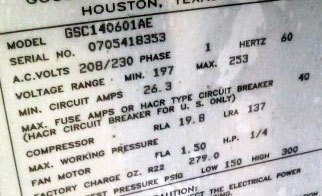 The camera can take pictures with resolutions ranging from 120 x 160 pixels all the way up to full 1536 x 2048 pixels. Default operation is via the Pictures & Videos application that offers a good variety of image capture and playback options. You can play slide shows, designate a picture as the Today wallpaper, beam a shot via Bluetooth, email in various sizes, and so on. In capture mode you can set a self-timer or do 5-picture burst mode (not very fast but maybe still useful), you can set white balance as well as brightness. In video mode you record at 352 x 288 pixels and set time limits (30 seconds to 30 minutes). The camera can take pictures with resolutions ranging from 120 x 160 pixels all the way up to full 1536 x 2048 pixels. Default operation is via the Pictures & Videos application that offers a good variety of image capture and playback options. You can play slide shows, designate a picture as the Today wallpaper, beam a shot via Bluetooth, email in various sizes, and so on. In capture mode you can set a self-timer or do 5-picture burst mode (not very fast but maybe still useful), you can set white balance as well as brightness. In video mode you record at 352 x 288 pixels and set time limits (30 seconds to 30 minutes).
All of this is operated by the Windows software that even with the X7's speedy processor is a bit slow and cumbersome, with the usual Windows Mobile combination of menus, pulldowns and check boxes. Picture quality is reasonable albeit nowhere close to a dedicated camera. The frame rate of video is low. The camera function of the Nautiz X7 is clearly meant to increase the unit's usefulness by letting you document things when you don't have a camera with you, but it does not replace a camera.
Note that Microsoft's sluggish Camera application is often replaced by third party applications that work much better, or developers and systems integrators include camera and video functionality directly into custom applications.
Power
The Nautiz X7 is powered by a rechargeable 5,600mAh 3,7 Volt Lithium-Ion battery. This amounts to a very generous 21 watt-hours--much more than most handhelds. We measured the device as drawing less than two watts, depending on backlight level and whether or not the wireless radios were on. Handheld claims "all day operation." Based on the power draw, that is definitely possible.
The battery is part of the backside of the unit and fits flush into the device. A rotating bolt secures the battery cover and makes for a tight fit. It is unlikely that it will accidentally open.
Ruggedness
The Nautiz X7 is an ultra-rugged device. Its impact-resistant plastic housing, protective bumpers, and overall design and construction make it able to handle the use and abuse that may be encountered in industrial applications.
Handheld rates the unit as capable of handling multiple 4-foot drops. It's been tested and certified according to the new MIL-STD 810G, Method 516.5, Procedure IV that mandates 26 drops from 4 feet. It then was subjected to six additional drops at -22F and six more at a blistering 140F.
The unit has an extremely wide operating temperature range from -22 to 140 degrees Fahrenheit. This makes the Nautiz platform able to handle operation in freezers as well as desert-like conditions.
Sealing — the ability to keep out dust and water — is crucial for a handheld computer. The Nautiz X7 carries an IP67 ingress protection rating. The "6" means the unit's inside is totally sealed against dust. The "7" means it is water-proof and can be submerged in water.
Summary
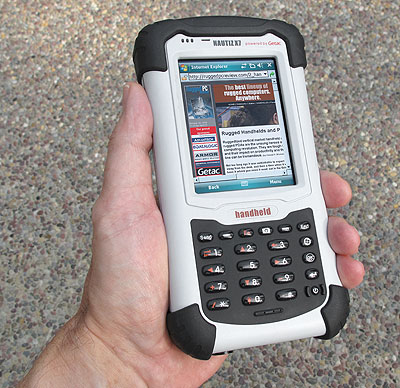 The Nautiz X7, offered by Handheld U.S., is an ultra-rugged Windows Mobile PDA with integrated GPS, altimeter, e-compass, camera, and a hi-res display suitable for all sorts of GIS surveying and other GPS/mapping-based applications.
The Nautiz X7, offered by Handheld U.S., is an ultra-rugged Windows Mobile PDA with integrated GPS, altimeter, e-compass, camera, and a hi-res display suitable for all sorts of GIS surveying and other GPS/mapping-based applications.
It is built around Microsoft Windows Mobile 6.1 and the 806MHz Marvell PXA310 processor (the fastest currently available XScale processor for mobile devices), has a brilliant full-VGA 3.5-inch touch display, and can function both as a PDA as well as a full-function quad-band GSM/GPRS/EDGE smartphone and a tri-band UMTS/HSDPA data communicator (all you have to do is insert an activated SIM). Featuring a smooth, purposeful industrial look and feel, the Nautiz X7 is a tough tool for demanding jobs that require extreme temperature tolerance as well as the ability to handle multiple 4-foot drops. IP67 sealing means the unit is totally dustproof as well as waterproof, even with immersion.
The Nautiz X7 packs a lot of advanced functionality into one single device. It is a full-function Pocket PC with mobile versions of Office apps as well as email, messaging, browsing and numerous utilities. It can be used as a full-function smartphone with excellent integration into the PDA part of the unit. Mapping and GIS applications are available via the integrated SiRF III GPS receiver. For data capture you can add an optional RFID reader or barcode scanner. An internal 3-megapixel camera with LED illuminator light can be used to document data or even take video, with the usual limitations such integrated cameras have. The numeric keypad allows for very rapid data entry. The unit's powerful battery provides full-day operation.
Overall, the Nautiz X7 offers a well-balanced combination of advanced technology, Pocket PC convenience and targeted professional GIS features in a package tough enough to be used virtually anywhere. Also worth noting is the unit's three year warranty. We haven't seen many of those as of late.
-- Conrad H. Blickenstorfer
Handheld U.S. Nautiz X7 Specs:
| Added/changed |
Added 10/2009
|
| Type |
Ultra-rugged GPS handheld
|
| Processor |
806MHz Marvell PXA310 XScale application processor |
| OS |
Windows Mobile 6.1 Classic or Professional
|
| GPS |
SiRFstarIII; 5 meter accuracy autonomous, 1-3 meters SBAS (WAAS/ENGOS/MSAS); post process: sub-meter
|
| RAM/ROM |
128MB/4GB NAND FLASH |
| Display |
3.5" 18-bit color transflective TFT with VGA (480 x 640 pixel) resolution and LED backlight |
| Digitizer |
Touch screen |
| Keyboard/keys |
22-key keypad |
| Navigation |
4-way directional control and stylus/touch
|
| Expansion slots |
1 externally accessible SD/SDHC Card slot (up to 16GB); 1 SIM
|
| Housing |
ABS plastic with rubberized bumper areas
|
| Size |
3.5 x 7.0 x 1.5 inches
|
| Weight |
17.6 oz. as tested
|
| Operating temperature |
-22 to 140 degrees Fahrenheit (MIL-STD 810G, Method 501.4, Procedure II) |
| Ingress protection |
IP67, IEC 529 MIL-STD 810G, Method 512.4, Procedure I, Water Jet 12.5 mm dia. @ 2.5 - 3m, 100 Liter/min. |
| Humidity |
MIL-STD 810G, Method 507.4, 90%RH temp cycle 30~60 ¯C |
| Drop |
MIL-STD 810G, Method 516.5, Procedure IV 26 drops from 4 ft (1.22 m) 6 additional drops at -22 ¯F (-30 ¯C), 6 additional drops at 140¯F (60 ¯C) |
| Vibration |
MIL-STD 810G, Method 514.5 Procedure I |
| Tumble |
1,000 1.6 ft./.5 m tumbles (2,000 drops) |
| ESD |
estimated: IEC61000-4-2 / EN55024 |
| Power |
Li-Ion 3.7 Volt, 5,600mAh, 21 watt-hours ("all day operation") |
| Communication |
802.11b/g WiFi, Bluetooth Class 2 V2.0 + EDR, 3.0-megapixel camera with LED flash, altimeter, compass; optional integrated 3.5G HSDPA/WCDMA/EDGE/GPRS/GSM WWAN, cordless 1D Bardcode Reader, cordless RFID reader |
| Interface |
Mini AB USB OTG (1.2 host, 2.0 client), 9-pin serial, microphone, line-out, power |
| Price |
US$1,699; HSDPA model US$2,099 |
| Contact |
www.handheld-us.com and www.nautiz.com |
(copyright 2009 RuggedPCReview.com)
HHCS Handheld USA Inc.
33870 SE Eastgate Circle
Corvallis, OR 97333, USA
Tel: (541) 752-0313
Fax: (541) 752-0338
Web: www.handheld-us.com
Email: info @ handheld-us.com
|





 From a tech perspective, the designers and engineers who created this machine set the bar pretty high. On the display side, the 3.5" touchscreen display has full VGA 480 x 640 pixel resolution. That translates into 228 dots per inch, considerably sharper even than the Apple iPhone's 162dpi display. Combined with transflective sunlight-readable display technology, the very high resolution makes for excellent viewing quality of graphic-intensive files and detailed maps, even in bright daylight or snowy conditions.
From a tech perspective, the designers and engineers who created this machine set the bar pretty high. On the display side, the 3.5" touchscreen display has full VGA 480 x 640 pixel resolution. That translates into 228 dots per inch, considerably sharper even than the Apple iPhone's 162dpi display. Combined with transflective sunlight-readable display technology, the very high resolution makes for excellent viewing quality of graphic-intensive files and detailed maps, even in bright daylight or snowy conditions.
 The Nautiz X7 also offers plenty of storage in the form of 4GB of onboard NAND Flash that can be complemented with an additional 8GB through an SDHC card slot.
The Nautiz X7 also offers plenty of storage in the form of 4GB of onboard NAND Flash that can be complemented with an additional 8GB through an SDHC card slot.


 Among them are mobile versions of Word, Excel, PowerPoint and OneNote. It also includes PIM applications, mail, web browsing, Windows Messenger, a picture viewer and a good number of control panels.
Among them are mobile versions of Word, Excel, PowerPoint and OneNote. It also includes PIM applications, mail, web browsing, Windows Messenger, a picture viewer and a good number of control panels.


 Above the display are three indicator lights. The one to the left glows blue when the phone is turned on. The one in the center flashes blue for Bluetooth, amber for WiFi and purple for GPS. The right one indicates charge status.
Above the display are three indicator lights. The one to the left glows blue when the phone is turned on. The one in the center flashes blue for Bluetooth, amber for WiFi and purple for GPS. The right one indicates charge status.

 When using the Nautiz as a phone, you can tell that Microsoft has a good seven years of Pocket PC phone experience. Everything works and everything is logical and nicely integrated. For our testing I used the SIM card from one of our AT&T phones and it worked without as much as additional configuration. The X7's voice quality is very good, and, as is usually the case with vertical market handhelds that are also phones, actually better than that of most of today's chintzy dedicated phones. It's also quite obvious why Microsoft used to call this the "Pocket PC Phone Edition" -- they did not just add cell phone capability to a rugged PDA; the wireless capabilities are deeply integrated into the device and its software.
When using the Nautiz as a phone, you can tell that Microsoft has a good seven years of Pocket PC phone experience. Everything works and everything is logical and nicely integrated. For our testing I used the SIM card from one of our AT&T phones and it worked without as much as additional configuration. The X7's voice quality is very good, and, as is usually the case with vertical market handhelds that are also phones, actually better than that of most of today's chintzy dedicated phones. It's also quite obvious why Microsoft used to call this the "Pocket PC Phone Edition" -- they did not just add cell phone capability to a rugged PDA; the wireless capabilities are deeply integrated into the device and its software.

 The Nautiz X7 comes standard with integrated 802.11b/g WiFi as well as Bluetooth V2.0 + EDR. A SIM slot, located inside the battery compartment, enables the unit to function as a phone and also enables HSDPA wireless WAN (Wide Area Network) communication. Select models are equipped with a HSDPA (High-Speed Downlink Packet Access) module. HSDPA is an enhanced 3G (third generation) mobile telephony communications protocol that can operate on the 850/900/1800/1900/2100MHz bands.
The Nautiz X7 comes standard with integrated 802.11b/g WiFi as well as Bluetooth V2.0 + EDR. A SIM slot, located inside the battery compartment, enables the unit to function as a phone and also enables HSDPA wireless WAN (Wide Area Network) communication. Select models are equipped with a HSDPA (High-Speed Downlink Packet Access) module. HSDPA is an enhanced 3G (third generation) mobile telephony communications protocol that can operate on the 850/900/1800/1900/2100MHz bands.
 Like almost all modern handhelds and smartphones, the Nautiz X7 has an integrated camera. Thanks to advanced CMOS imager technology, it is now possible to have high resolution still and video camera functionality even in very small devices. In terms of speed and image quality, these camera modules are not meant to replace a standard photographic camera by any means; they are simply meant to provide additional functionality.
Like almost all modern handhelds and smartphones, the Nautiz X7 has an integrated camera. Thanks to advanced CMOS imager technology, it is now possible to have high resolution still and video camera functionality even in very small devices. In terms of speed and image quality, these camera modules are not meant to replace a standard photographic camera by any means; they are simply meant to provide additional functionality.
 The camera can take pictures with resolutions ranging from 120 x 160 pixels all the way up to full 1536 x 2048 pixels. Default operation is via the Pictures & Videos application that offers a good variety of image capture and playback options. You can play slide shows, designate a picture as the Today wallpaper, beam a shot via Bluetooth, email in various sizes, and so on. In capture mode you can set a self-timer or do 5-picture burst mode (not very fast but maybe still useful), you can set white balance as well as brightness. In video mode you record at 352 x 288 pixels and set time limits (30 seconds to 30 minutes).
The camera can take pictures with resolutions ranging from 120 x 160 pixels all the way up to full 1536 x 2048 pixels. Default operation is via the Pictures & Videos application that offers a good variety of image capture and playback options. You can play slide shows, designate a picture as the Today wallpaper, beam a shot via Bluetooth, email in various sizes, and so on. In capture mode you can set a self-timer or do 5-picture burst mode (not very fast but maybe still useful), you can set white balance as well as brightness. In video mode you record at 352 x 288 pixels and set time limits (30 seconds to 30 minutes).
 The Nautiz X7, offered by Handheld U.S., is an ultra-rugged Windows Mobile PDA with integrated GPS, altimeter, e-compass, camera, and a hi-res display suitable for all sorts of GIS surveying and other GPS/mapping-based applications.
The Nautiz X7, offered by Handheld U.S., is an ultra-rugged Windows Mobile PDA with integrated GPS, altimeter, e-compass, camera, and a hi-res display suitable for all sorts of GIS surveying and other GPS/mapping-based applications.